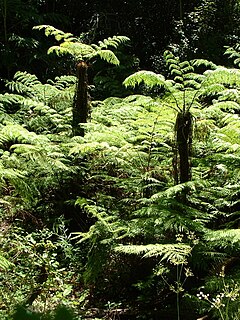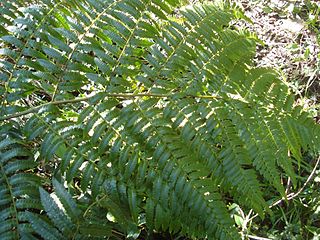
Cyathea cooperi, also known as the Australian tree fern, lacy tree fern, scaly tree fern, or Cooper's tree fern, is a tree fern native to Australia, in New South Wales and Queensland.
Cyathea brooksii is a species of tree fern native to Cuba, Hispaniola and Puerto Rico, where it grows on serpentine soils in shaded ravines, along streams, and on forested slopese at an altitude of 250–950 m. The trunk is prostrate and only about 6 cm in diameter. Fronds are pinnate or bipinnate and up to 2 m long. The base of the rachis is covered with blackish scales that have a paler margin. Sori occur in two rows, one along each side of the pinnule midvein.

Cyathea capensis is a regionally widespread and highly variable species of tree fern. It is indigenous to Southern Africa and South America.
Cyathea caudata is a species of tree fern native to the islands of Luzon and Mindanao in the Philippines, where it grows in montane forest. The trunk is erect and up to 4 m tall or more. Fronds are bi- or tripinnate and 1–2 m long. The stipe is warty and covered with dark, narrow, glossy scales. Sori are borne near the midvein of fertile pinnules and are protected by firm, brown indusia.
Cyathea chinensis is a species of tree fern native to Yunnan in China, Sikkim in India, as well as Nepal, Myanmar, Laos and Vietnam. Plants grow in forest and montane forest at an altitude of 900–1800 m. The trunk is erect and 1–2 m tall. Fronds are bipinnate and 1–2 m long. The stipe is either long and warty or has short spines towards the base as well as scattered glossy dark brown scales with fragile edges. Sori occur near the midvein of fertile pinnules and are covered by thin indusia.

Cyathea colensoi, also known as the Creeping Tree Fern, Mountain Tree Fern and Golden Tree Fern, is a species of tree fern native to New Zealand, from the southern part of the North Island south to Stewart Island. It grows in submontane to montane forest in damp areas, particularly near the tree line. The trunk is usually prostrate, but may sometimes be erect. It may reach about 1 m in height. Fronds are tripinnate and about 1.5 m long or more. The rachis and stipe are slender, pale brown and are covered with brown scales. Sori occur in two rows, one along each side of the fertile pinnule midvein, and lack indusia. Plants form a thicket with no sign of a trunk.

Cyathea cunninghamii, also known as the gully tree fern and slender tree fern, is a species of tree fern indigenous to New Zealand including North Island, South Island and Chatham Islands; also to Victoria, possibly New South Wales, southeastern Queensland and Tasmania in Australia. It grows in damp forest, often emerging from stream gullies and riverbanks. Brownsey noted that it has a lower tolerance for drought than other species of Cyathea. The erect trunk may be 20 m tall and is usually 6–15 cm in diameter, occasionally as much as 20 cm. Fronds are tri- to tetrapinnate and 3 m or more in length. The rachis and stipe are slender, black brown, warty and covered with brown scales. Sori occur along each side of the pinnule midvein and are covered by hood-like indusia. C. cunninghamii is an uncommon and slow-growing tree fern.

Cyathea dregei is a widespread species of tree fern in southern Africa.
Cyathea × dryopteroides is a tree fern native to Puerto Rico, where it grows at an altitude of 1000–1200 m. It is now known to be of hybrid origin between Cyathea amintae and Cyathea bryophila.
Cyathea edanoi is a species of tree fern endemic to Luzon in the Philippines, where it grows in montane forest at an altitude of about 1300 m. The trunk is erect and 1–2 m tall. Fronds are bi- or tripinnate and approximately 1 m long. The stipe is covered in dark, glossy scales that have narrow, fragile edges. Sori occur near the midvein of fertile pinnules and are covered, sometimes half-covered, by large, firm, brown indusia.
Cyathea squamulata is a species of tree fern native to the Malay Peninsula, Sumatra, Java, Borneo and the southern Philippines, including the Sulu Archipelago, where it grows in forest from the lowlands to an altitude of about 1500 m. The trunk is erect and up to 2 m tall. Fronds are pinnate or bipinnate and approximately 1.5 m long. The stipe is covered in densely packed firm, medium brown scales. Sori occur near the fertile pinnule midvein and lack indusia.
Cyathea glabra is a species of tree fern native to Borneo, western Java, Sumatra and the Malay Peninsula, where it grows in lowland swamp forest and montane forest at an elevation of up to 1500 m. The trunk of this plant is erect and 2–4 m tall. Fronds are bi- or tripinnate and 1–2 m in length. Characteristically of this species, the lowest pinnae may be significantly reduced. The stipe is very dark and bears basal scales. These scales are dark, glossy and have a paler margin and fragile edges. Sori are produced in groups of one to three on fertile pinnule veins. They lack indusia.
Cyathea hancockii is a species of tree fern native to the Ryukyu Islands, Japan, Taiwan and Hong Kong. The specific epithet hancockii commemorates William Hancock (1847-1914), who collected numerous plants in Japan, China and Southeast Asia. It grows in forest, on stream banks, and in forest margins at an elevation of about 600 m or higher.
Cyathea heterochlamydea is a little-known species of tree fern native to the islands of Luzon, Panay, Negros and Mindanao in the Philippines, where it grows in montane forest. The trunk of this plant is erect and usually up to 4 m tall or more. Fronds may be bi- or tripinnate and 1–2 m in length. The stipe is warty and/or bears short spines and scales. These scales are dark, glossy and have a narrow pale margin. Sori are borne near the fertile pinnule midvein and are protected by firm, brown indusia.

Cyathea delgadii is a widespread species of tree fern native to Costa Rica, Panama, Venezuela, French Guiana, Guyana, Trinidad, Colombia, Ecuador, Peru, Bolivia, Argentina, Paraguay, and Brazil.
Cyathea × marcescens, commonly known as the skirted tree fern, is a tree fern endemic to the Cape Otway ranges in Victoria and Tasmania, Australia. It is a natural hybrid, apparently Cyathea australis × Cyathea cunninghamii. Braggins and Large (2004) note that it has characteristics midway between these two species. The spores of C. × marcescens are usually malformed although sterile. The trunk of this plant is erect and up to 10 m tall. Fronds may be bi- or tripinnate and 3–4 m in length. Dead fronds often persist, forming a characteristic skirt around the trunk. The stipe is thick, black and warty. The rachis and trunk are covered in shiny, dark brown scales. Sori are borne near the fertile pinnule midvein and are protected by thin indusia that are saucer-like in appearance.
Cyathea metteniana is a species of tree fern native to the Ryukyu Islands, Japan, and Taiwan, where it grows in wet forest, forest margins, and on hillsides. The trunk of this plant is erect, up to 1 m tall, and 6–10 cm in diameter. C. metteniana has tripinnate fronds that are 1-2.5 m long. The stipe is brown to purple-black in colouration. It is covered in long, broad-based scales that are usually bicoloured. Sori are round, lack indusia, and occur in two rows, one on either side of the pinnule midvein.
Cyathea imbricata is a species of tree fern endemic to Western New Guinea, where it grows in open forest at an altitude of 3240 m. The trunk of this plant is erect and approximately 2 m tall. Fronds may be bi- or tripinnate and are usually less than 1 m in length. The stipe is dark, spiny, and covered with caducous scales. These scales are glossy brown in colouration and have a paler margin and fragile edges. Sori are borne in groups of one to four per pinnule lobe. They are protected by firm indusia.
Alsophila is a section in the subgenus Cyathea. The name was originally applied to a genus of tree ferns which is now considered to be synonymous with Cyathea.

Cyathea smithii, commonly known as the soft tree fern or kātote, is a species of tree fern from New Zealand.










